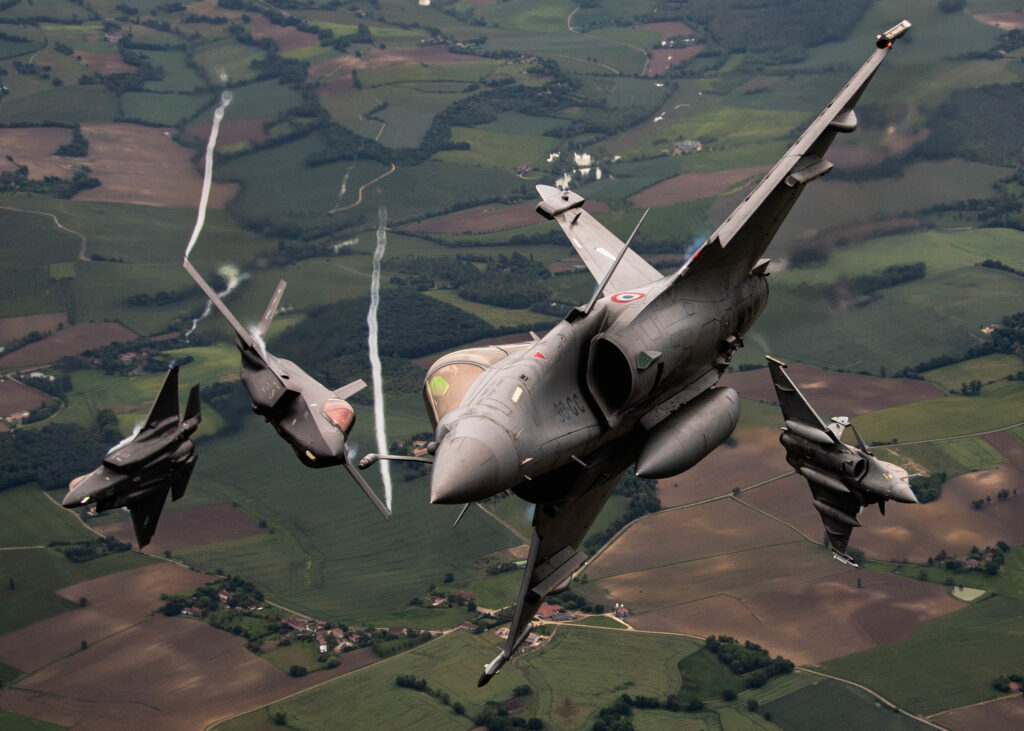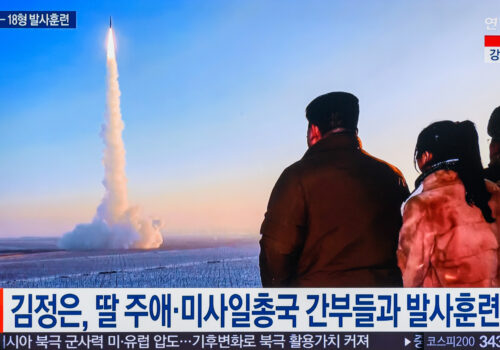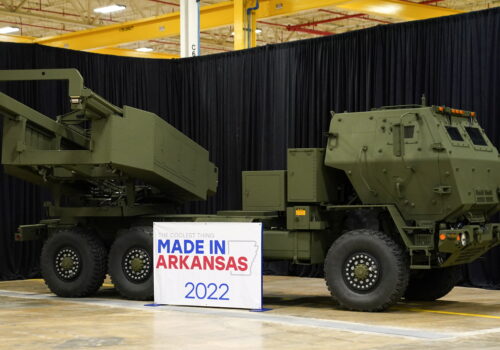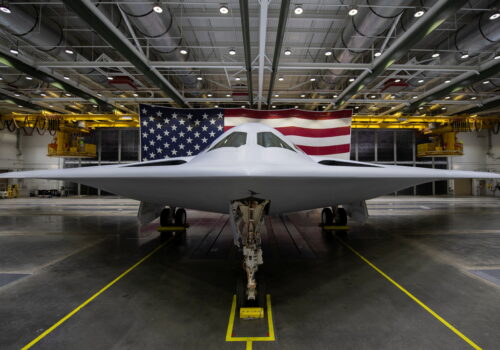The United States has a two-pronged approach to strategy making, with both a National Security Strategy and a National Defense Strategy. These documents function as roadmaps for policymakers, guiding military planning, shaping other Department of Defense initiatives, and informing resource allocation to address the most significant threats facing the nation.
But these strategies depend on a robust industrial base. A healthy industrial sector enables deterrence against aggression, battlefield success in times of conflict, and the maintenance of a technological edge over adversaries. While the importance of this sector has long been recognized, it wasn’t until this year that both the United States and the European Union (EU) formally introduced dedicated defense industrial strategies.
Why? The war in Ukraine was a wake-up call to the West—one which exposed lengthy production timelines, capability gaps, supply chain vulnerabilities, workforce deficiencies, and a number of other inefficiencies in both the United States and Europe. While both the US National Defense Industrial Strategy and European Union Defence Industrial Strategy prioritize building resilience and fostering innovation, their success hinges on transatlantic cooperation. But only one of the strategies embraces the need for sustained commitment and close cooperation.
While the US strategy emphasizes cooperation with allies and partners, the EU’s strategy is looking to break dependence on US military hardware. To do so, it seeks to establish a new European Defence Industry Programme aimed at boosting weapons production on the continent. While the strategic disparity has raised concerns in Washington, it’s important to discern the difference between geopolitics and managing transnational defense industrial integration. Multilateral collaboration on developing, producing, and maintaining military equipment takes years, and, in some cases, decades of policy work and alliance building; these relationships do not unravel overnight.
The United States often struggles to meet defense capacity needs, which requires overcoming its own bureaucratic hurdles. The challenges of coordinating defense efforts are only amplified when dealing with a complex structure such as the EU. National interests, protectionism, and ingrained bureaucratic apparatuses have historically hampered defense industrial collaboration within the EU. Further complicating matters, EU treaties restrict the use of funds for direct military spending despite the defense industry falling under the European Commission’s domain. Past attempts to regulate it proved unsuccessful due to concerns about duplicating NATO’s role and EU member states’ reluctance to cede control over defense industrial matters. While EU member states can invoke the national security clause to circumvent the European Commission’s authority and single market rules, the Commission may investigate and challenge the invocation if the spending does not fall under national security concerns.
Challenges for transatlantic cooperation
The consolidation of the industrial base has created single points of failure for production when suppliers run into problems. These issues are further exacerbated by cyberattacks, which disrupt production, compromise sensitive data, and facilitate intellectual property theft. Both the US and EU strategies diagnose supply chain challenges as a major contributor to unfavorable conditions as a result of global dependence, consolidation, and cybersecurity threats.
Addressing concerns about overreliance on foreign suppliers, the EU is setting up a Security of Supply regime to build resilience and a competitive edge for the European defense technology industrial base and its supply chains. Meanwhile, the United States is establishing a Supply Chain Disruptions Task Force to mitigate disruptions and integrate allies and partners more deeply into its supply chains.
Both strategies aim to strengthen resilience by reducing reliance on single sources and exploring the reshoring of critical materials production, enhancing stockpiles of essential equipment and subcomponents, and strengthening cybersecurity measures.
Fostering innovative defense technology is also a goal of both strategies. They aim to achieve this through investment in research and development of next-generation technology, such as artificial intelligence, hypersonics, and autonomous systems. They also both seek to streamline acquisition and enhance public-private partnerships. Strengthening collaboration between the private sector and government alone is a hefty feat, which is why both strategies support joint research and development, private sector incentives, and exchanging best practices.
In theory, these aims are one and the same, but a closer look at doctrinal and cultural differences sheds light on where these efforts diverge. As a global power, the United States has a long-standing motivation to sustain its dominance in military capabilities and its ability to project power. The National Defense Strategy explicitly states the need to maintain military superiority and deter US adversaries from challenging a free and open order. This aligns closely with Pax Americana, a term that identifies the United States as the global security guarantor and superpower.
Europe, on the other hand, seems motivated by the desire to increase its autonomy. For years, a few European leaders have periodically bandied about the idea of strategic autonomy in the sense of building up both the capability and the will to act independently from the United States or another major power. For just as long, however, little has come of this idea. Nonetheless, the impulse toward greater European autonomy, even if short of full autonomy, has proved remarkably resilient. This impulse shows up, for example, in the European Defence Industrial Strategy, specifically when it comes to the dependency on US military hardware. The strategy makes it a priority to eliminate “excessive external dependencies or bottlenecks” from the industrial base, noting that “the volume of acquisitions made through the US Foreign Military Sales (FMS) in the EU has increased by 89 percent between 2021 and 2022.”
Beyond diverging ambitions and the difficulty of securing reliable supply chains, a significant challenge to transatlantic collaboration lies in the inherent competition between US and EU defense companies. Both sides vie for a significant share of the global defense market (estimated at two trillion dollars in 2023), potentially incentivizing contractors to prioritize winning individual bids over collaborative efforts. This competitive dynamic is further amplified by existing procurement policies such as “Buy American” in the United States and EU preference rules in Europe, which can restrict competition and hinder cross-border collaboration.
In the United States, export controls have limited technology transfers to allies and partners long before the war in Ukraine. These controls include the International Traffic in Arms Regulations on defense technology and information and Export Administration Regulations on dual-use materials. Not only do these negatively impact European partners who experience a lack of reciprocity, they also discourage US companies from collaborating with foreign partners, fearing denials or delays that tack on years to project timelines. Meanwhile, member states must now harmonize fragmented national procurement processes across the EU to even the playing field for their own firms—let alone US contractors attempting to navigate multinational defense projects.
In short, industrial cooperation and strategic alignment are not mutually inclusive in the near term. Divergent strategic directions will eventually impact the alignment and coordination necessary for industrial cooperation, but not today. The real challenge won’t be found in differing objectives on the horizon, but in the array of obstacles facing the United States and the EU now.
To overcome these hurdles, both the United States and the EU need to explore alternative procurement models that encourage collaboration over competition. Additionally, streamlining export control processes with the same emphasis devoted to AUKUS (the trilateral partnership between Australia, the United Kingdom, and the United States) and fostering a culture of trust and reciprocity are crucial steps toward strengthening transatlantic cooperation in defense.
Kathryn Levantovscaia is a deputy director in the Forward Defense program of the Atlantic Council’s Scowcroft Center for Strategy and Security.
Further reading
Thu, Apr 11, 2024
Is the United States falling behind the North Korean ICBM threat? Congress needs answers.
New Atlanticist By Robert Soofer
Washington must not wait until Pyongyang is regularly test-launching ICBMs with multiple re-entry vehicles and countermeasures to improve US defenses.
Thu, Apr 4, 2024
Aiding Ukraine is a strategic investment, not charity
New Atlanticist By Kathryn Levantovscaia
Some members of Congress are concerned about costs, but US support for Ukraine is an investment in US economic and national security that is already paying off.
Wed, Feb 14, 2024
Reading between the lines of the new US National Defense Industrial Strategy
New Atlanticist By
The new strategy’s strength as a rallying cry for a robust industrial base is hampered by an absence of specifics on implementation.
Image: Two US Air Force F-35A Lightning IIs assigned to the 4th Fighter Squadron, Hill Air Force Base, Utah, and two Dassault Rafales assigned to the 1/4 Gascogne Fighter Squadron, 113 Saint-Dizier-Robinson air base, France, break formation during flight May 18, 2021 over France. The flight was apart of the Atlantic Trident 21 exercise. (US Air Force photo by Staff Sgt. Alexander Cook)



